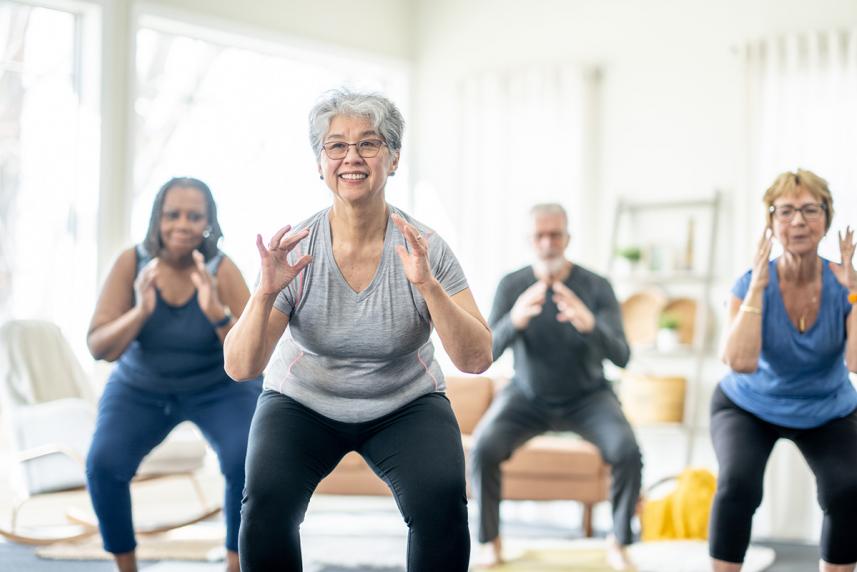The older adult’s guide to getting more active
It’s never too late to reap the health benefits of exercise. These six expert tips will help you set up a safe (and fun) fitness routine.

Most of us are pretty clear on the fact that exercise does a body good. Research shows that staying active has a wide range of benefits — lowering your risk of disease, protecting your body from injury, and boosting your mood.
If you haven’t worked out lately (or in years) and think it’s too late, two words: It’s not. You can start a fitness routine at any age. And, for older adults, incorporating more movement into your life can be especially impactful for strength, balance, and stress relief.
The recommended goal is 150 minutes of moderate to intensive aerobic activity — or about 2 1/2 hours — each week, according to the National Institute on Aging. That might sound intimidating, but it breaks down to just 20 to 30 minutes a day. Or you can focus your efforts on just three days a week.
There are many ways to make fitness work for you and your lifestyle. Get started with these six tips from Josie Dutil, director of the Council on Aging/Senior Center in Bellingham, Massachusetts.
Take advantage of your HMSA Well-Being Lifestyle Resources. Hawaii–based health coaches are available to help you create a plan and offer support as you work toward your goals. Learn more about Health Coaches and other Lifestyle Resources here.
1. Get cleared
Almost anyone, of any age, can safely do some kind of exercise. That’s true even if you’re a beginner or managing a health condition. But as an older adult, it’s important to talk to your health care provider before trying any new exercise or increasing your level of activity. (Need a doctor? Search now with Find a Doctor.)
Make sure your provider is aware of any injuries, aches, or pains you may have. Discuss any ongoing or chronic health conditions and whether certain types of exercise are off-limits. Ask which exercises are best for you.
Also bring up any medications you’re taking, including prescriptions, over-the-counter drugs, and supplements. Certain medications may impact your exercise routine, and your provider can explain what you need to know to stay safe.

Use Find a Doctor on hmsa.com to search for a participating provider near you today.
2. Go slow and steady
You don’t have to jump into a high-intensity fitness class right away. Frankly, that’s not likely to be the best way to set yourself up for success.
Pushing yourself too hard or fast is a common mistake, and you can wind up injured or burned out. Begin with lower-impact activities, such as walking, swimming, or seated aerobics. As you get stronger and gain confidence, you can try new activities.
3. Make exercise a habit
Do you do certain things at certain times, such as checking the mail or watering plants? Treat exercise the same way. Find the best time for your workout and make it part of your everyday routine.
The reason this works: Our brains like knowing what’s coming up. Having a scheduled time to exercise also makes it less likely that other things will get in the way. Think of exercise as an important appointment with yourself for your health.
4. Take advantage of fitness equipment
For people who weren’t into sports or haven’t really exercised much before, machines can provide an assist. Cardio machines, in particular, offer many exercise options. A stationary bike is a great starting point because it’s easy on the joints. A treadmill lets you walk or jog without worrying about uneven terrain or bad weather.
If you’ve never used a cardio machine, a trainer or staff member at the gym can walk you through it. Or use the great outdoors to get the same effects as a machine. Consider climbing stairs in a park or high school stadium, for example, instead of using a stair-climbing machine. Just make sure you’re feeling steady — or climb next to a railing to keep your balance.
5. Try workout classes
Sometimes, people need a little extra motivation to get moving. That’s where workout classes come in. One easy option is to stream workout classes from YouTube, where many are available at no charge.
Or try combining exercise with socializing. Support from others with similar goals can help keep you on track (and make things fun). Look for complimentary fitness classes in your community.
Your HMSA plan can help too! Learn more about your fitness benefit, Silver&Fit™*, and how it can help support your wellness goals.
6. Stick with the program
The key to a good exercise routine is doing it regularly. It should be sustainable, not overwhelming. That means figuring out a setup you’re going to stick with.
Here are two ways to go:
- Exercise at least 30 minutes a day, five days a week. If you can’t do 30 minutes in one session, break it up into three 10-minute sessions. Add time gradually until you can do a full 30 minutes at once.
- Keep your activity to three days a week. This could mean 45- to 50-minute sessions each of the three days. Or you could do a longer session on one day and then shorter sessions on the other two days.
Whichever way you go, you may also want to mix up your routine: Do balance exercises one day, with aerobic activity such as walking or riding a bike on the other days.
And if you miss a day or go short on time, don’t beat yourself up. That can make you more prone to skipping the next day or giving up entirely. Show yourself compassion and know that establishing an exercise regimen is a journey. One that puts you on the road to better health.
See our sources:
How older adults can get started with exercise: National Institute on Aging
Benefits of physical activity: Centers for Disease Control and Prevention
Overcoming barriers to physical activity: Centers for Disease Control and Prevention
Gym memberships and fitness programs: Medicare.gov
*The Silver&Fit program is provided by American Specialty Health Fitness, Inc., a subsidiary of American Specialty Health (ASH). ASH is an independent specialty health organization, offering musculoskeletal health provider networks and programs, fitness center networks and programs, and well-being solutions on behalf of HMSA.
H3832_8750_3MKT638_25_C


